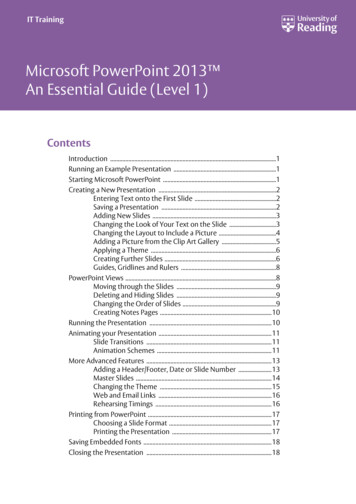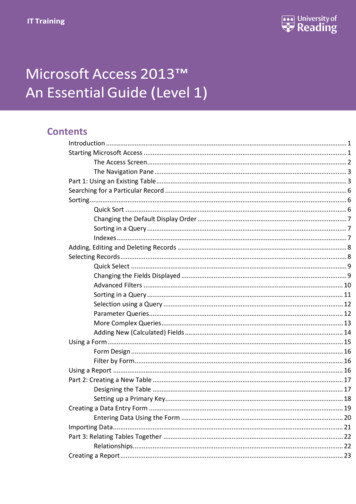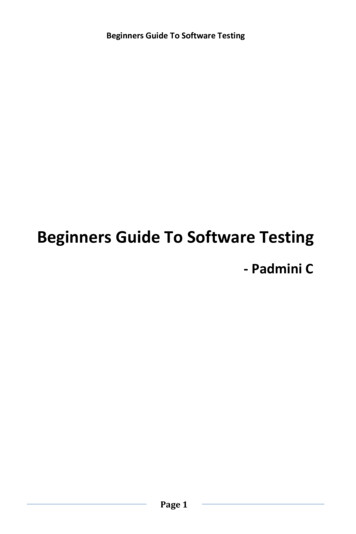
Transcription
Beginners Guide to Creating a SermonA guide for new ministers to preparing and creating Biblical sermons in the presence of GodBy David C. Istre
PERSONAL PREPARATIONPreparing to preach begins with the heart, soul, and mind of the preacher1. Pray and ask God to personally:a. convict your heart with the textb. challenge your life with the textc. illuminate your understanding with the textd. sanctify your whole being with the text2. Sanctify your studya. Set aside time to study and prepare in the presence of Godb. Defend your study and preparation time3. Meditate on the text untila. Christ takes hold of you through the textb. Christ indwells you through the textc. Christ softens your heart to the text4. Examine yourselfa. Am I humbled before Godb. Am I submitted to Godc. Am I honoring and revering the word of Godd. Am I personally prepared to preach the word of GodPreparing to preach is as much about preparing one’s heart, soul, and mind to become a vessel for the proclamation ofGod’s word as it is about acquiring the necessary knowledge and skills to write and preach a sermon.The preacher brings his whole being, life, vulnerabilities, expectations, hopes, vision, dreams, and fears into every lessonhe preaches; therefore, the preacher should bring his whole being, life, all of his vulnerabilities, expectations, hopes,vision, dreams, and fears before God when preparing to preach God’s word so that he can be made adequate by thegrace of Christ.Every point in this guide will look slightly different as God calls preachers of many different backgrounds to declare hisglory and demonstrate his grace. The aim, therefore, is to become personally fit to “preach the word of God” in thepresence of Christ and his kingdom.
IMMERSING INTO THE TEXTImmerse yourself in the text by reading and re-reading the text until you are fully immersed in it:1.2.3.4.5.6.7.8.Identify the full context of the textIdentify the full range of meaning by comparing translations of the textIdentify the major historic and cultural backgroundsIdentify the underlying Old Testament backgrounds or New Testament foregrounds of the textIdentify the main theological themes of the textIdentify the main arguments, propositions, and imperatives of the textIdentify the main application(s) of the textIdentify the major textual and apologetic issues of the textThe preacher should draw his sense of the Lord’s message from the text as the Holy Spirit illuminates his mind to God’smessage. The preacher should allow the Holy Spirit to captivate his heart with the text as he begins to immerse himselfinto God’s words. This process of immersing oneself into the text should never be rushed because it is where thepreacher will draw the life-breath of his sermon from.OUTLINNING THE TEXTCreate an outline using the natural flow of the text1. Outline the text according to its natural flow of thought2. Create your main points3. Write one proposition statement for each main pointThe best way to keep a message clear and focused is to follow the natural flow of the text by writing one clear propositionfor each main point of the text. This allows the voice of God’s word to be the preacher’s guide and anchor the preacher’ssermon to the authority of God’s word as he explores the application of God’s word for the lives of the Church.WRITING THE BODY OF THE SERMONExpand on the central propositions of your sermon to form the body of your lesson.1. Explore the implications of the text’s historic and cultural backgroundsa. Use the text’s historic and cultural backgrounds to color and emphasize the text’s message2. Explore the importance of the text’s Old Testament background or New Testament foregrounda. Use the text’s backgrounds/foregrounds to support the text’s messageb. Use these backgrounds/foregrounds as pillars to support the text’s theological connections3. Explore the text’s theological connectionsa. Use supporting Biblical texts to illuminate the text’s theological significance4. Explore the text’s full range of meaning found in other translationsa. Emphasize the text’s arguments, propositions, and imperativesb. Emphasize the text’s syntactical relationships to appropriately emphasize its meaning5. Explore the text’s applicationsa. How does the text inform our spiritual life?b. How does the text inform our physical life?c. How does the text interact with other worldviews and apologetic issues?The preacher should draw from the text the organic ideas, natural connections, and intended applications when creatingthe foundation of his sermon so that he can explore the depths of the text without losing the text’s intended message.
STREAMLINNING THE SERMONStreamline your lesson point by point to ensure your sermon flows together as one sermon.1. Read your main points togethera. Check accuracyb. Check coherencec. Check congruence2. Read your sub-pointsa. Look for superfluous points that are distracting to the messageb. Look for points that will disrupt the coherence of the main pointsc. Look for missing points3. Read your lesson with your audience in minda. Look for your audience in your lessonb. Look for points that need additional explanationc. Look for points that can encourage, challenge, or correct your audienceThe best way to make sure lessons connect to audiences without eroding the integrity of the message is to re-examinethe lesson after its body has been written. This is an opportunity to check the message’s accuracy, coherence, andcongruence to make sure that it isn’t being undermined by mistakes, inconsistencies, or distractions that will take awayfrom the impact of the message. The preacher should now connect the audience to his message by reading the messagewith its audience in mind and making any necessary changes or additions.FINISHING TOUCHESWrite the introduction and conclusion of your sermon once you have the full picture of your lesson.1. Write an introduction to emphasize the main point of the message2. Write a conclusion to bring the message together and connect it to the audience’s heart and mindThe most effective way to write an introduction and conclusion to a sermon is to write them after the body of the sermonis finished. Introductions should prepare the audience to see the central theme(s) of the message throughout the lesson.Conclusions should tie everything together and personally connect the body of the lesson to the audience.
BIBLICAL INSTRUCTIONThe following texts give strong Biblical counsel to those who preach the word of God to God’s people. Consider themcarefully and frequently as you fulfill your ministry.Ezra 7:10 (CSB) Now Ezra had determined in his heart to study the law of the LORD, obey it, and teach its statutes andordinances in Israel.Psalm 119:160 (CSB) The entirety of your word is truth, each of your righteous judgments endures forever.Isaiah 66:2 (CSB) This is the LORD’s declaration. I will look favorably on this kind of person: one who is humble, submissivein spirit, and trembles at my word.Matthew 28:20 (CSB) teaching them to observe everything I have commanded you. And remember, I am with you always,to the end of the age.John 17:17 (CSB) Sanctify them by the truth; your word is truth.John 21:15, 17 (CSB) When they had eaten breakfast, Jesus asked Simon Peter, “Simon, son of John, do you love me morethan these?” “Yes, Lord,” he said to him, “you know that I love you.” “Feed my lambs,” he told him. 17 He asked him thethird time, “Simon, son of John, do you love me?” Peter was grieved that he asked him the third time, “Do you love me?”He said, “Lord, you know everything; you know that I love you.” “Feed my sheep,” Jesus said.Acts 2:42 (CSB) They devoted themselves to the apostles’ teaching, to the fellowship, to the breaking of bread, and toprayer.Acts 20:27 (CSB) because I did not avoid declaring to you the whole plan of God.Romans 10:17 (CSB) So faith comes from what is heard, and what is heard comes through the message about Christ.1 Corinthians 3:7 (CSB) So then neither the one who plants nor the one who waters is anything, but only God who givesthe growth.1 Timothy 4:13 (CSB) Until I come, give your attention to public reading, exhortation, and teaching.2 Timothy 3:16–17 (CSB) All Scripture is inspired by God and is profitable for teaching, for rebuking, for correcting, fortraining in righteousness, 17 so that the man of God may be complete, equipped for every good work.2 Timothy 4:1–2 (CSB) I solemnly charge you before God and Christ Jesus, who is going to judge the living and the dead,and because of his appearing and his kingdom: 2 Preach the word; be ready in season and out of season; rebuke, correct,and encourage with great patience and teaching.1 Peter 1:23 (CSB) Because you have been born again—not of perishable seed but of imperishable—through the living andenduring word of God.2 Peter 1:20–21 (CSB) Above all, you know this: No prophecy of Scripture comes from the prophet’s own interpretation,21 because no prophecy ever came by the will of man; instead, men spoke from God as they were carried along by theHoly Spirit.
Beginners Guide to Creating a Sermon A guide for new ministers to preparing and creating Biblical sermons in the presence of God By David C. Istre . PERSONAL PREPARATION Pr











